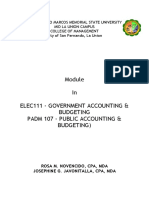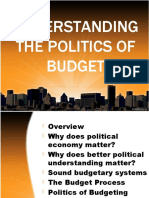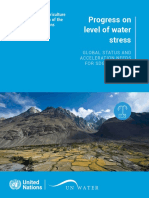LGU Budgeting Process
LGU Budgeting Process
Uploaded by
Gina Lee Mingrajal SantosCopyright:
Available Formats
LGU Budgeting Process
LGU Budgeting Process
Uploaded by
Gina Lee Mingrajal SantosOriginal Description:
Copyright
Available Formats
Share this document
Did you find this document useful?
Is this content inappropriate?
Copyright:
Available Formats
LGU Budgeting Process
LGU Budgeting Process
Uploaded by
Gina Lee Mingrajal SantosCopyright:
Available Formats
LOCAL REVENUE GENERATION
SECTION 129. Power to Create Source of Revenue - Each local government unit shall exercise its power to create its own sources of revenue and to levy taxes, fees, and charges subject to the provisions herein, consistent with the basic policy of local autonomy. Such taxes, fees, and charges shall accrue
a. Land-based Tools b. Community Activity-based Tools c. Infrastructure-based Tools d. Debt-based Tools e. Revenue sharing Tools
1. 2. 3. 4. 5. 6. 7. 8. 9. 10.
Basic Real Property Tax (Sec. 232). Special Education Fund SEF Real Property Tax (Sec. 235). Land Transfer Tax (Sec. 135). Idle Land Tax (Sec. 236). Public Land Use Tax (Sec. 235a). Land Sale of Foreclosed Real Properties (Sec. 257, 258 and 260). Land Investment Land Reclassification (Sec. 20). Land Development Permit Fee (557 and 558). Tax on Sand, Gravel and other Quarry Resources (Sec. 138).
1. 2. 3. 4. 5. 6. 7. 8. 9.
Business Tax (Sec. 143) Community Tax (Sec. 156) Franchise Tax (Sec. 137) Tax on Business of Printing and Publication (Sec. 136). Professional Tax (Sec. 139). Amusement Tax (Sec. 140). Annual Fixed Tax on Delivery Trucks or Vans (Sec. 141). Fishery Rentals, Fees and Charges (Sec. 149). Service Fees and Charges (Sec. 153).
1.Special 2.Toll
Levy (Sec 250) Fees or Charges (Sec. 155). Utility Charges (Sec. 155).
6
3.Public
1)Debt
302). 18
Financing (Sec. 297Investment (Sec
2)Financial
1)Share
in Mining, Fishery, and Forestry Taxes (Sec. 290). in the Gross Sales or Taxes of GovernmentOwned and Controlled Corporations (Sec. 291).
8
2)Share
Traditional method: Estimates income on the basis of
Past collections Newly enacted tax ordinances Amendments to existing tax or revenue ordinances Program of tax collection campaign
Revenue
forecasting
Estimates income based on the
average growth rate of the actual income for the last five years.
Presumptive Income Levels (PIL) estimates tax bases for business and amusement tax
Firms electric bill Number of employees Amount of inventory (countercheck the amount of gross receipts declared by the tax payer)
Collection
done mainly by the Treasurers office
(all taxes, fees and charges shall be
paid within the first twenty(20) days of January and of each subsequent quarter)
Factors affecting the collection efficiency of the local treasurers office Limited personnel Inadequate records-keeping and management systems Political mediation Precarious peace and order condition in the locality Low tax ethic Lack logistics Revenue data bank
Vertically
integrated planning
Provides local governments with the
connection to the broader and longerterm framework of development
Local
development planning
Identification of development programs
and projects that are appropriate for credit financing Basis for budget proposals and reference in preparing work and financial plans. Basis of recommendation of spending for
Local
Government Budget Process
Legal instrument which authorizes
the expenditure of public funds Accounting framework for fixing the fiscal stewardship of public offers Management tool for planning the direction and magnitude for the utilization of government revenues and receipts
Setting a local government budget involves three key decisions: 1) Allocation 2) Distribution 3) Stabilization/Growth The Allocation Decision is based in three criteria: 1) Economic efficiency 2) Technical efficiency 3) Net social benefits/costs
Budgeting Cycle
Executive Budget Local Chief Executive Local Finance Committee Done between July 15 and October 15 of the current year Transmitted to the Local Sanggunian not later than October 16
Legislative discussion of proposed budget is done by the Sanggunian between October 16 and November 17 Enact annual budget by issuing an appropriation ordinance on or before the current fiscal year
Submission of the budget for review is required within 10 days
The review action by the reviewing authority may lead to either the declaration of the budget as to the following :
This phase involves the release and actual disbursement of funds for the identified functions Work and Financial Plan and Request for Allotment
Budget
Preparation
Expenditure items
Mandatory contributions (required prior to the Codes effectivity) Social security and insurance benefits of employees Reserve money for earned leave credits of retiring employees Gratuities of employees that are optionally retiring Personal services
Budget
Authorization
Conflicts between the executive and
legislative branches of the local government cause the delay of the passage of the budget (opposing political camps/party)
Budget
Review
Change in the process of review of
appropriation led to non-conformity of review actions and decisions
Some sanggunians would authorize anything appropriated by lower level of local units for political purposes Failure to submit supporting documents on time
Budget
Execution
Non submission of work and financial
plan and request for allotments by the heads of departments or offices Non submission of supporting documents for the request for allotments. Use of appropriated funds or savings
Budget
Accountability
Delayed submission of financial
statements to the local finance committee by the local accountant LGU failed to prepare development programs for the 20% Development Plan LGU appropriated funds for development projects less than the level of appropriation required LGUs failed to implement or complete
Budget
Accountability
Incurrence of cash drafts due to
improper use of trust funds Disbursements which lead to disallowances after audit Failure by LGUs t conduct periodic physical inventory or to maintain complete property records Failure to liquidate cash advances, thus making those advances accumulate through the years.
You might also like
- FLEXPATHDocument2 pagesFLEXPATHGina Lee Mingrajal Santos100% (4)
- Business Plan Template For A Transport CompanyDocument19 pagesBusiness Plan Template For A Transport CompanyMariam Oluwatoyin Campbell76% (55)
- Coca Cola Sales and DistributionDocument15 pagesCoca Cola Sales and DistributionRajdeep Roy Chowdhury100% (2)
- Budget ProcessDocument6 pagesBudget Processjd_prgrin_coNo ratings yet
- Final Local Fiscal AdministrationDocument5 pagesFinal Local Fiscal AdministrationOliver SantosNo ratings yet
- SLPBC Presentation DILGDocument24 pagesSLPBC Presentation DILGDanpaul SantosNo ratings yet
- List of Local Special BodiesDocument1 pageList of Local Special BodiesMarieta AlejoNo ratings yet
- 11 DOF BLGF Local Revenue Generation and LGU ForecastingDocument20 pages11 DOF BLGF Local Revenue Generation and LGU ForecastingDilg Sadakbayan100% (3)
- Book 1: Updated Local Treasury Operations Manual (Ltom)Document87 pagesBook 1: Updated Local Treasury Operations Manual (Ltom)Gian Bayaras100% (1)
- Basic Rules and Regulations On Collections and DepositsDocument15 pagesBasic Rules and Regulations On Collections and DepositsLalaine Castillo100% (1)
- The House System: Together Everyone Achieves MoreDocument2 pagesThe House System: Together Everyone Achieves MoreGina Lee Mingrajal SantosNo ratings yet
- Battle of The Bands MechanicsDocument1 pageBattle of The Bands MechanicsGina Lee Mingrajal Santos100% (1)
- Municipal ProfileDocument51 pagesMunicipal ProfileGina Lee Mingrajal Santos100% (1)
- Week 10 - Models of Corporate Social ResponsibilityDocument10 pagesWeek 10 - Models of Corporate Social ResponsibilityZybel RosalesNo ratings yet
- Financing Philippine Local GovernmentDocument33 pagesFinancing Philippine Local GovernmentJUDY ANN GASPARNo ratings yet
- Government AccountingDocument13 pagesGovernment AccountingReniella Villondo100% (1)
- Principles of Public BudgetingDocument56 pagesPrinciples of Public BudgetingDM SilonganNo ratings yet
- 1 Fiscal Organization of Local GovernmentsDocument26 pages1 Fiscal Organization of Local GovernmentsBen JNo ratings yet
- LTOM Final Book 1Document72 pagesLTOM Final Book 1Antonette Contreras DomalantaNo ratings yet
- New Laws and Rules On Expenditures and Disbursements (ATA)Document52 pagesNew Laws and Rules On Expenditures and Disbursements (ATA)Maria Julieta Stephanie TacogueNo ratings yet
- Seminar Workshop On The Updating of Municipal Revenue CodeDocument37 pagesSeminar Workshop On The Updating of Municipal Revenue CodeOren Estabillo Mendoza100% (1)
- Local Fiscal AdministrationDocument12 pagesLocal Fiscal AdministrationJanice Aguila Suarez - Madarang100% (1)
- Concept of Funds-Dr. Loida M. CancinoDocument81 pagesConcept of Funds-Dr. Loida M. CancinoAricirtap Abenoja JoyceNo ratings yet
- Lgu Credit FinancingDocument79 pagesLgu Credit FinancingAmanoden Mala DimalutangNo ratings yet
- Budget Preparation: Republic of The Philippines Department of Budget and ManagementDocument55 pagesBudget Preparation: Republic of The Philippines Department of Budget and ManagementFernando ComedoyNo ratings yet
- Accounting Office Citizen's Charter SampleDocument50 pagesAccounting Office Citizen's Charter Sampleryanpacabis23100% (2)
- Local Fiscal AdministrationDocument18 pagesLocal Fiscal AdministrationLander Dean S. ALCORANONo ratings yet
- Local Budget ProcessDocument30 pagesLocal Budget ProcessRona Lyn Marin100% (4)
- Philippine Budget CycleDocument35 pagesPhilippine Budget CycleJetJet Linso100% (12)
- Budget Process: (Local Government Budget Administration)Document12 pagesBudget Process: (Local Government Budget Administration)Aigene Pineda100% (1)
- Statement of Receipts and ExpendituresDocument69 pagesStatement of Receipts and Expendituresginny100% (1)
- In Elec111 - Government Accounting & Budgeting Padm 107 - Public Accounting & Budgeting)Document36 pagesIn Elec111 - Government Accounting & Budgeting Padm 107 - Public Accounting & Budgeting)Erika MonisNo ratings yet
- Local Funds Management and UtilizationDocument89 pagesLocal Funds Management and UtilizationJennylyn Favila Magdadaro100% (8)
- DBM BudgetDocument85 pagesDBM BudgetGab Pogi100% (1)
- Revenue and Treasury Management Offices in The PhilippinesDocument73 pagesRevenue and Treasury Management Offices in The Philippinesmarj berting67% (3)
- Lecture Notes On Philippines BudgetingDocument9 pagesLecture Notes On Philippines Budgetingzkkoech92% (12)
- Book 1: Updated Local Treasury Operations Manual (Ltom)Document88 pagesBook 1: Updated Local Treasury Operations Manual (Ltom)Ah MhiNo ratings yet
- BclteDocument2 pagesBcltereiman0590No ratings yet
- Blcte Reviewer 11Document10 pagesBlcte Reviewer 11Josue Sandigan Biolon SecorinNo ratings yet
- Public Fiscal AdministrationDocument119 pagesPublic Fiscal AdministrationWilson King B. SALARDA100% (2)
- Understanding The Politics of BudgetDocument21 pagesUnderstanding The Politics of BudgetVellinRobisoDatuinNo ratings yet
- The New BarangayDocument36 pagesThe New BarangayShekeinah CalingasanNo ratings yet
- Government AccountingDocument5 pagesGovernment AccountingPrincessa Lopez Masangkay100% (1)
- DBM E-BUDGET LGU360 USERS MANUAL v1.0 20160623 PDFDocument108 pagesDBM E-BUDGET LGU360 USERS MANUAL v1.0 20160623 PDFJoanna Stephanie RodriguezNo ratings yet
- Book 1: Updated Local Treasury Operations Manual (Ltom)Document87 pagesBook 1: Updated Local Treasury Operations Manual (Ltom)RhapsodyNo ratings yet
- Bclte FormDocument3 pagesBclte Formjune florezNo ratings yet
- Legislative Acts As Bases For Public PolicyDocument37 pagesLegislative Acts As Bases For Public PolicyKathleen Abubo100% (1)
- Local Finance CommitteeDocument3 pagesLocal Finance CommitteeKei SenpaiNo ratings yet
- Overview of The NGAs New Barangay Accounting SystemDocument2 pagesOverview of The NGAs New Barangay Accounting SystemHarPearl Lie100% (1)
- Local Fiscal Administration: Gilbert R. HufanaDocument27 pagesLocal Fiscal Administration: Gilbert R. Hufanagilberthufana44687767% (3)
- Calamity Fund Guidelines PDFDocument41 pagesCalamity Fund Guidelines PDFMylyn Cajucom100% (4)
- AOM 2020-005 (16-19) Ila Iyam ReimbursementsDocument2 pagesAOM 2020-005 (16-19) Ila Iyam Reimbursementsvivian cavidaNo ratings yet
- Budget ProcessDocument9 pagesBudget ProcessDindin100% (2)
- What Is Bottom-Up Budgeting?Document10 pagesWhat Is Bottom-Up Budgeting?Mikki Eugenio88% (16)
- Local Revenue Generation and LGU ForecastingDocument17 pagesLocal Revenue Generation and LGU ForecastingRichard Mendez100% (1)
- Overview of Government Accounting: Topic 1Document18 pagesOverview of Government Accounting: Topic 1Cherrie Arianne Fhaye Naraja100% (1)
- Reviewer in Local GovernmentDocument36 pagesReviewer in Local GovernmentNiles Adam C. RevillaNo ratings yet
- Local Public Financial Management Tools For ESREDocument54 pagesLocal Public Financial Management Tools For ESRERandy Sioson100% (1)
- Managing Financial Resources in The GovernmentDocument93 pagesManaging Financial Resources in The GovernmentBarney's Gaming Squad100% (1)
- A Citizen's Guide To Understanding Local Government Units' Finances, Systems and FunctionsDocument16 pagesA Citizen's Guide To Understanding Local Government Units' Finances, Systems and FunctionsMarivic SorianoNo ratings yet
- Local Govt Budget For Sanggunian MembersDocument161 pagesLocal Govt Budget For Sanggunian MembersPatrick Go100% (1)
- Book 2: Updated Local Treasury Operationsmanual (Ltom)Document144 pagesBook 2: Updated Local Treasury Operationsmanual (Ltom)Ah Mhi100% (1)
- C. MPA Governance and Management Plan (BROP) : General Island and Ayoke Marine Protected AreaDocument32 pagesC. MPA Governance and Management Plan (BROP) : General Island and Ayoke Marine Protected ArealyneroballagulNo ratings yet
- BOM Manual 2016 Edition FINALDocument236 pagesBOM Manual 2016 Edition FINALALLAN H. BALUCAN100% (2)
- Philippines: Public-Private Partnerships by Local Government UnitsFrom EverandPhilippines: Public-Private Partnerships by Local Government UnitsNo ratings yet
- Non Gov ReviewerDocument426 pagesNon Gov ReviewerMA. CHRISTINA BUSAINGNo ratings yet
- Orion Executive Summary 2023Document5 pagesOrion Executive Summary 2023Ronel CadelinoNo ratings yet
- Rules For OfficeDocument1 pageRules For OfficeGina Lee Mingrajal Santos100% (1)
- ISO 9001:2008 Quality Management System (QMS) Work Instruction ManualDocument4 pagesISO 9001:2008 Quality Management System (QMS) Work Instruction ManualGina Lee Mingrajal SantosNo ratings yet
- Love vs. LustDocument1 pageLove vs. LustGina Lee Mingrajal SantosNo ratings yet
- Platinum Sponsorship - P100, 000.00 and UpDocument1 pagePlatinum Sponsorship - P100, 000.00 and UpGina Lee Mingrajal SantosNo ratings yet
- What Is ISA?: ISA Is A Quality Assurance Process That Assesses The Through The Use ofDocument3 pagesWhat Is ISA?: ISA Is A Quality Assurance Process That Assesses The Through The Use ofGina Lee Mingrajal SantosNo ratings yet
- Operation ManagementDocument2 pagesOperation ManagementGina Lee Mingrajal Santos0% (1)
- ASQ0511 201306AQSManagementSystemDocument4 pagesASQ0511 201306AQSManagementSystemGina Lee Mingrajal SantosNo ratings yet
- Scoring Rubric and Instructions For PRACTICUM PAPER Student: - Paper Components Outline Required Components Met Partially Met Not Met NADocument2 pagesScoring Rubric and Instructions For PRACTICUM PAPER Student: - Paper Components Outline Required Components Met Partially Met Not Met NAGina Lee Mingrajal SantosNo ratings yet
- A Letter To MyselfDocument2 pagesA Letter To MyselfGina Lee Mingrajal SantosNo ratings yet
- Report TheoryDocument18 pagesReport TheoryGina Lee Mingrajal SantosNo ratings yet
- Plant LocationDocument32 pagesPlant LocationGina Lee Mingrajal SantosNo ratings yet
- Basic Managerial Roles and Skills: InterpersonalroleDocument22 pagesBasic Managerial Roles and Skills: InterpersonalroleKartik AroraNo ratings yet
- Teaching ProfessionDocument16 pagesTeaching ProfessionGina Lee Mingrajal SantosNo ratings yet
- BOSS Presentation Academic PDFDocument41 pagesBOSS Presentation Academic PDFfarizanNo ratings yet
- Fusion ScreenshotDocument13 pagesFusion ScreenshotMadhusudan ParwalNo ratings yet
- Practical Research 2 Group 1Document22 pagesPractical Research 2 Group 1Luis ConcepcionNo ratings yet
- Chapter 14Document59 pagesChapter 14mas aziz100% (1)
- 1 Why The Working Class?: Education For SocialistsDocument32 pages1 Why The Working Class?: Education For SocialistsDrew PoveyNo ratings yet
- Capital Gains Tax Acc202Document11 pagesCapital Gains Tax Acc202Lynn TaneoNo ratings yet
- Introduction To Mathematical Economics (Aug 2017)Document9 pagesIntroduction To Mathematical Economics (Aug 2017)Majo MuyrongNo ratings yet
- Daewoo Express PakistanDocument123 pagesDaewoo Express Pakistanshahidzaman80% (5)
- Akuntansi Dan Keuangan 27.1 (2022) : 1-10Document1 pageAkuntansi Dan Keuangan 27.1 (2022) : 1-10nimas celica putri athayaNo ratings yet
- Accounting For RoyaltiesDocument19 pagesAccounting For RoyaltieskwameNo ratings yet
- Jaguar Security Services Private LTD 137Document1 pageJaguar Security Services Private LTD 137Deepak SharmaNo ratings yet
- Toluene GlobalDocument6 pagesToluene GlobaltotpityiNo ratings yet
- The Lean Canvas: Problem Solution Unique Value Prop. Unfair Advantage Customer SegmentsDocument1 pageThe Lean Canvas: Problem Solution Unique Value Prop. Unfair Advantage Customer SegmentsSumeet Chaurasia100% (1)
- Q1 2023 Cap Rate Report AYDocument4 pagesQ1 2023 Cap Rate Report AYKevin ParkerNo ratings yet
- Dell-Big Data-AnalysisDocument39 pagesDell-Big Data-AnalysisZara ImranNo ratings yet
- Achieving Operation Excellence and Customer Intimacy Enterprise ApplicationsDocument23 pagesAchieving Operation Excellence and Customer Intimacy Enterprise ApplicationsSinzihara Mazina Guy OctaveNo ratings yet
- Null 001.2024.issue 065 enDocument69 pagesNull 001.2024.issue 065 ensimonrosariojohnpeterNo ratings yet
- Capital Account ConvertibilityDocument9 pagesCapital Account ConvertibilityShihas Muhammed AshrafNo ratings yet
- Cipla LTD Analyst ReportDocument11 pagesCipla LTD Analyst ReportManpreet Singh BhatiaNo ratings yet
- Import Documentation Requirement For Customs ClearanceDocument3 pagesImport Documentation Requirement For Customs ClearanceanuboraNo ratings yet
- FM II Chapter 1, Capital Structure Policy and LeverageDocument58 pagesFM II Chapter 1, Capital Structure Policy and LeverageibsaashekaNo ratings yet
- A Comparative Study of HRM Practices ofDocument3 pagesA Comparative Study of HRM Practices ofSai Yamini YaminiNo ratings yet
- Strategi Perusahaan Bidang Konstruksi Dalam Menghadapi Resesi Ekonomi (Studi Kasus PT Adhi Karya (Persero) TBK)Document9 pagesStrategi Perusahaan Bidang Konstruksi Dalam Menghadapi Resesi Ekonomi (Studi Kasus PT Adhi Karya (Persero) TBK)faisal al sunandi100% (1)
- 13.final Project WorkDocument49 pages13.final Project WorkMeenakshi MeenaNo ratings yet
- Technical ProposalDocument10 pagesTechnical ProposalturboNo ratings yet
- FAO 2021 - Progress On Level of Water StressDocument96 pagesFAO 2021 - Progress On Level of Water StressSofiDuendeNo ratings yet
- Pennar Engineered Building Systems LimitedDocument466 pagesPennar Engineered Building Systems Limitedtuv srinuvasaNo ratings yet










































































































